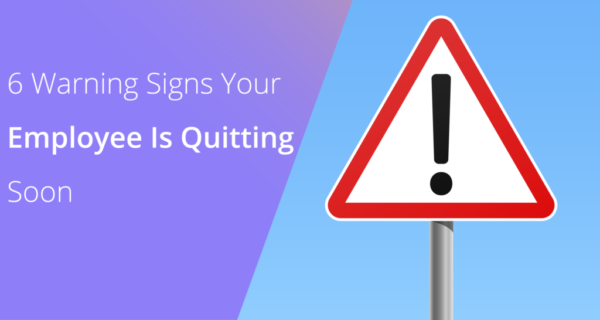6 Warning Signs Your Employee Is Quitting Soon
Ever been blindsided by an employee quitting? You were worried about Rep A and it was Manager B who resigned? According to Gallup, managers have higher disengagement than reps today – and we’re at our highest overall dissatisfaction since 2000!
Here are some behaviors to keep on your radar to prevent your top employees from quitting:
-
Disengagement.
You may think it’s the active nay-sayer who’s your problem child, but it’s actually the quiet ones. This is especially true if you used to hear from them. As employees move from “engaged” to “disengaged” they withdraw. You may find you have to call on them in a huddle when they used to speak up. It might be that when you do ask for their input, it is short and not well thought out.
-
Absence.
It takes work time to interview elsewhere and if your employee is virtual it will be harder to notice. Look for long response times on Slack or email and 90-minute call gaps. If they’ve gone radio silent, they’re likely searching and interviewing elsewhere. They won’t be asking for all of this time off, they’ll likely just be taking it during lunches, starting late or ending early. If your spidey sense says there might be a problem, look for numerous gaps over several weeks.
-
Low Performance.
You may not see it right away, but when you look for it, you’ll see productivity or ratios declining. Probably over several periods. Often I find that one big miss will start the disengagement for normally great reps. For example, Bobby was a solid A or B player and he had a big whiff three months ago. As per policy, he went on a PIP. He pulled himself back up, but never back to the “A” status. Start checking for declines in outbounding and longer absences. Call on Bobby in meetings and see what happens. You lost him at the write-up, and in the absence of great ego coddling, he may have checked out back then.
-
High Demands.
You won’t find this one in any research, but I tell you I’ve seen it. As an employee starts to check out, they don’t all fade out. I’ve had some make it my fault. They start asking for more and more demanding requests – perhaps even the impossible. When I can’t or won’t deliver, they have “no choice” but to leave. Look for rising demands around hours, travel, or approved expenses. They may even be shopping you against another job posting or company.
-
New Requests.
Be careful not to classify new requests in the high demands category. In the past few years, priorities have shifted and hyper-engaged employees expect their employers to be doing more. If you don’t have diversity plans in place including employee programs, training, equality hiring, and pay practices, you are soon to be in trouble. The same goes for work hours/days, location flexibility, and career development and training opportunities. These are all top demands of the new generations and you’ll need to meet them to attract and retain employees. If you’re getting requests here and you don’t have it in place or are soon to be deployed, get ready for some resignations.
-
Disinterest in Learning.
The best salespeople are lifelong learners. When they stop engaging with training opportunities, books, or team training, you know they’re checking out. You’ll see the same with decreasing engagement with other departments, special projects, and all-company concerns.

When all else fails (and even if it doesn’t), sit and talk with your team about their engagement. Wait, what? Address it head-on? Absolutely! Gallup also reported that it takes more than a 20% pay increase to lure an employee away who is engaged with their manager. Turns out YOU are the difference. See what reports, emails, and silly tasks you can delegate so you can do 2 more coaching sessions this week. The more time you spend with your team getting to know them and developing them (read: NOT talking about the numbers), the greater your chance to retain your stars and you’re at-risk.

